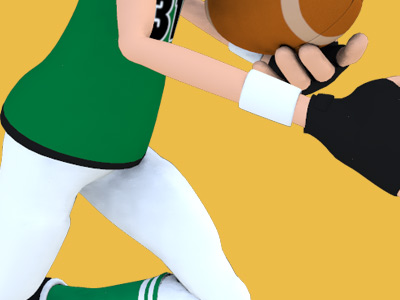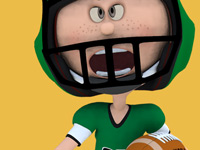American football

Single-wing formation (American Football Strategy)
In American and Canadian football, a single-wing formation, created by Glenn "Pop" Warner, was a precursor to the modern spread or shotgun formation. The term usually connotes formations in which the snap is tossed rather than handed—formations with one wingback and a handed snap are commonly called "wing T" or "winged T". The single wing was superior to the T formation in its ability to get an extra eligible receiver down field.
Single-wing style of play
The direct snap or toss from the center usually went to the tailback or fullback; however, the quarterback could also take the ball. The tailback was very important to the success of the offense because he had to run, pass, block, and even punt. Unlike today, the quarterback usually blocked at the point of attack. As with his modern day counterpart, a single-wing quarterback might also act as a field general by calling plays. The fullback was chosen for his larger size so that he could "buck" the line. This meant that the fullback would block or carry the ball between the defensive tackles. The wingback could double-team block with an offensive lineman at scrimmage or even run a pass route.
The single-wing formation was designed to place double-team blocks at the point of attack. Gaining this extra blocker was achieved in several ways. First, the unbalanced line placed an extra guard or tackle on one side of the center. Second, a wingback stationed outside end could quickly move to a crucial blocking position. Third, the fullback and especially the quarterback could lead the ball carrier producing interference. Finally, linemen, usually guards, would pull at the snap and block at the specified hole. Line splits were always close except for ends who might move out from the tackle.
The single-wing formation depended on a center who was skilled both at blocking and at tossing the ball from between his legs to the receiving back. The center had to direct the ball to any of several moving backs, with extreme accuracy, as the play started. Single-wing plays would not work efficiently if the back had to wait on the snap because quick defensive penetration would overrun the play. The center was taught to direct the ball to give the tailback or fullback receiver a running start in the direction that the play was designed to go. The single-wing formation was a deceptive formation with spectators, referees, and defensive players often losing sight of the ball. A backfield player, called a "spinner", might turn 360 degrees while faking the ball to the other backs, or even keeping the ball or passing it. Defensive players were often fooled as to which back was carrying the ball.
The one play that was unique to the single-wing formation was the buck-lateral series. The terminology for this series of plays associates the word "buck" with the intent of the fullback to plunge into the line. In addition, the short toss, or lateral of the ball, can be made to the quarterback or wingback who may take the ball and do other maneuvers including passing the ball. Consequently, when the fullback takes the ball, he appears to be headed to buck the line. Typically, fullbacks were bigger players who ran plays intended to smash the defensive front. The fullback's initial move pulls the defensive players toward the expected point of attack. Next, the fullback tosses the ball to another back causing the defense to change pursuit angles, thus losing a step in their catching the ball carrier.
The strong side of the formation, where the extra lineman and wingback lined-up, put pressure on the defensive end. Defenses might move extra players to that side or shift the whole defense to compensate. The cut-back play could succeed regardless of how the defense reacted. The cut-back play started like a strong side sweep with offensive guards and quarterback running interference for the tailback. The fullback would fake a smash over the guard hole to occupy the defensive tackles. The play was designed to make the defensive end overreact and try to stay outside to contain the runner. If the defensive end gave ground to the sideline, the tailback would cut-back inside to let his interference push the defensive end out of the play. If the defensive end came too far inside, then the ball carrier would run around him to the outside. After the cut-back play was used in a game, then the offense might run the wingback reverse since both plays started out the same way. At the outset, the defense tries to pursue the sweeping tailback. However the tailback delivers the ball to the wingback running the opposite way to the weak side. Both the cut-back and the reverse would be set up with quick fullback bucks up the middle, which would cause the defensive line to over-protect their gaps, as opposed to pursuing quickly to the sideline.
Single-wing teams used both a standard punting formation and a quick punt, often kicking on second or third downs. The quick punt, or quick kick, saw the tailback-punter quickly backing up 5 yards as the ball was in the air from the center to distance him from rushers. The strategy was to keep defensive halfbacks, expecting a possession play, from dropping back to return the ball. The standard punt formation was often used for either punting as well as running or passing the ball. Most teams had a litany of plays that they might run from a punt formation. Prior to 1930 the shape of the football was a prominent oval shape called a prolate spheroid. Due to the shape of the ball, single-wing backs handled the ball more like a basketball, with short tosses and underhand lobs. Gradually, balls were allowed to be elongated enough to produce streamlined passes with a spiral. The spiraled ball could be thrown farther with more accuracy, thus increasing the potential for offenses to use the forward pass more frequently.
The single-wing quarterback played a different role than modern-day quarterbacks. While the quarterback may have called the snap count due to his position close to the center of the formation, he may not have called the actual play in the huddle. For much of the history of football, coaches were not allowed to call plays from the sideline. This responsibility may have gone to the team captain. The quarterback was expected to be an excellent blocker at the point of attack. Some playbooks referred to this player as the blocking back. The quarterback also had to handle the ball by faking, handing off, or optioning to other backs.
Modern use
Although the single-wing has lost much of its popularity since World War II, its characteristic features are still prevalent in all levels of modern football. They include pulling guards, double teams, play action passes, laterals, wedge blocking, trap blocking, the sweep, the reverse and the quick kick. Many current offenses, such as the spread option, use single-wing tendencies for running plays, while using wide receivers instead of wingbacks. Once a strong running formation, the single wing has been replaced by formations that facilitate passing, while minimizing the running aspect of the game. Today the single-wing has evolved into what coaches call the spread offense or shotgun, with the emphasis on passing. The most noticeable feature that remains of the powerful Carlisle formation is the long toss from center to the main ball-handler. The main talent and field general has become the quarterback instead of the tailback. The other single-wing backs have moved close to the line of scrimmage and are split farther from the main line. Wide receivers are called split-ends, flex ends, slots, and flankers. Also, linemen spacing has increased in distance. Moving offensive players farther apart serves the purpose of also spreading the defense. The goal is to make defenses cover the whole field on every play.
SPORTS



American Football
Game play in American football consists of a series of downs, individual plays of short duration, outside of which the ball is dead or not in play. These can be plays from scrimmage – passes, runs, punts, or field goal attempts (from either a place kick or a drop kick) – or free kicks such as kickoffs and fair catch kicks. Substitutions can be made between downs, which allows for a great deal of specialization as coaches choose the players best suited for each particular situation. During a play, each team should have no more than 11 players on the field, and each of them has specific tasks assigned for that specific play.
Rules and gameplay
- Scoring
- Maneuvers
- Strategy
- Play types
- Penalties
- Turnovers
- Downs
- Teams and positions
- Field
- Equipment
- Duration and time stoppages
- Advancing the ball and downs
- Kicking
- Officials and fouls
Positions
Offensive (Interior) line
Backs and receivers
Defensive line
Linebackers
Defensive backs
Special teams
- Kicker (K)
- Holder (H)
- Long snapper (LS)
- Punter (P)
- Kickoff specialist (KOS)
- Kick returner (KR) and Punt returner (PR)
- Upback
- Gunner
- Jammer


RESOURCES
This article uses material from the Wikipedia articles "American football", "American football rules", "Strategy", "Single-wing formation", which is released under the Creative Commons Attribution-Share-Alike License 3.0.
© Stories Preschool. All Rights Reserved.





